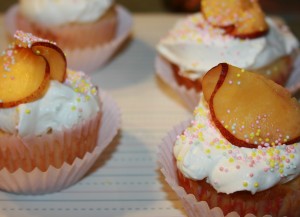Readable Feast
Flight Behavior – Discussion Questions
Barbara Kingsolver’s book, The Poisonwood Bible, is one of my top five favorite books ever. The complexity in her writing is astounding, touching on religious beliefs, socioeconomic class structure, environmental concerns, and human nature. Flight Behavior by Barbara Kingsolver is no different. It is a rich, picturesque novel about poverty, everyday miracles, and lost causes.
Synopsis
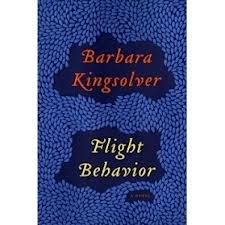 Set in the present day in the rural community of Feathertown, Tennessee, Flight Behavior tells the story of Dellarobia Turnbow, a petite, razor-sharp 29-year-old who nurtured worldly ambitions before becoming pregnant and marrying at seventeen. Now, after more than a decade of tending to small children on a failing farm, oppressed by poverty, isolation and her husband’s antagonistic family, she has mitigated her boredom by surrendering to an obsessive flirtation with a handsome younger man.
Set in the present day in the rural community of Feathertown, Tennessee, Flight Behavior tells the story of Dellarobia Turnbow, a petite, razor-sharp 29-year-old who nurtured worldly ambitions before becoming pregnant and marrying at seventeen. Now, after more than a decade of tending to small children on a failing farm, oppressed by poverty, isolation and her husband’s antagonistic family, she has mitigated her boredom by surrendering to an obsessive flirtation with a handsome younger man.
In the opening scene, Dellarobia is headed for a secluded mountain cabin to meet this man and initiate what she expects will be a self-destructive affair. But the tryst never happens. Instead, she walks into something on the mountainside she cannot explain or understand: a forested valley filled with silent red fire that appears to her a miracle.
After years lived entirely in the confines of one small house, Dellarobia finds her path suddenly opening out, chapter by chapter, into blunt and confrontational engagement with her family, her church, her town, her continent, and finally the world at large.
-From Harper Collins
Discussion Questions
Harper Collins has a wonderful selection of brilliant questions for discussion. Consider the following additional discussion questions for your book club:
- “Southern Appalachian culture, [Kingsolver] says, is “mostly derided in the world—hillbillies are one of the last ethnic groups who are routinely mocked without consequence.” (Telegraph interview) Consider the focus on anti-bully messages, why do you think we still deride and ridicule cultures as adults? Is it human nature?
- Did you learn anything about the Southern Appalachian culture? Did their lifestyle give you insight into challenges faced by today’s American impoverished?
- Dellarobia explains the culture in Feathertown to Ovid. “Sports. That’s huge, a kid can shine if he’s good at football or baseball. Probably get a job later on in the bank or something like that.” ( page 223) Have you ever encountered thinking similar to this?
- “Religion is like underwear – it’s very important and you keep it next to you all the time and you don’t talk about it,” Kingsolver has said in interviews, yet many of her books delve deeply into religion. How do the two different factions (religion and science) view the phenomenon of the butterflies?
- Why do you think Dellarobia stopped smoking?
- Kingsolver writes, “Being a stay at home mom is the loneliest kind of lonely.” (page 59) Have you ever been a stay at home mom? What was your biggest challenge? What is it about motherhood which can seem isolating and polarizing?
- “She knew there was something wrong with her. Some insidious weakness in her heart or resolve that would let her fly off and commit to some big nothing, all of her own making.” (page 80) Would Dellarobia have left if the butterflies never appeared? What kind of life would she have had?
- Why did the photo of Dellarobia become a meme? Why do memes and other short attention span entertainment options keep our attention while larger, important issues (such as climate change) don’t?
- Eventually the butterflies become common place, or less-miraculous to the townspeople. Why do we discount miracles when we’ve had too much exposure to them?
- Can you draw any parallels between Dellarobia’s exposure to the thrift store and the butterflies?
- When an activist shows Dellarobia the pamphlet on how to lower your carbon footprint, he is stunned when he finds almost nothing is applicable to her and her neighbors. It is marked contrast between the haves and the have-nots. What can each learn from each other?
- Concerning global warming, Ovid has a very fatalistic view. Without encouraging contentious discussion, what are your views on climate change and global warming? What can be done? What are you doing?
Kingsolver writes “Animals behave with purpose, unlike people.” (Page 42) One of the wonderful things about novels is the studied complexity of people and their interactions. In literary novels like Flight Behavior, truth and revelation can often be seen more clearly in fiction.
I will be posting the recipe for Nectarine cupcakes later this week. May words nourish your soul.
Triple Berry Cobbler – The Round House
The Round House focuses on traditional Native American foods such as bannock (fry bread), Res steak sandwiches (bologna sandwich on commodity bread with commodity cheese), and wild meats. I did create an upscale Res steak sandwich with pancetta, French cheese, rye bread, and pesto which helped round out the meal.
This berry cobbler can be made in one large 9 x 13” pan or in individual ramekin dishes. The individual dishes allow for easier distribution in a book club meeting.
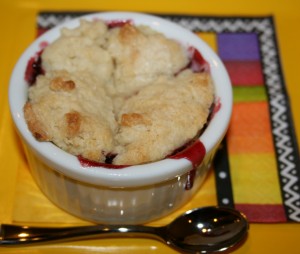 Triple Berry Cobbler
Triple Berry Cobbler
- 2 cups mixed berries (strawberries, blueberries, raspberries, blackberries)*
- 1/4 cup (half stick) butter, at room temperature
- 1/2 cup sugar
- 1-1/4 cups flour
- 1/2 cup milk
- 2 teaspoons baking powder
- 1/2 teaspoon salt
- 1 teaspoon vanilla
- 1/2 cup warm water
- 1/4 cup sugar
*You can also used canned berries. It takes approximately two full cans.
Directions
Preheat oven to 350 degrees.
Spray 13 x 9 pan or individual ramekins with non-stick spray.
Evenly spread mixed berries into the baking dishes. Place dish on a foil-covered baking sheet.
In a bowl, mix butter, sugar, flour, milk, baking powder, salt and vanilla with a wooden spoon, until thoroughly mixed. Spoon batter over fruit and spread evenly.
Mix remaining 1/4 cup sugar and 1/2 cup warm water. Pour evenly over dish(es). This sweetens the berries as well as browns the crust.
Bake for 50-55 minutes, until topping is golden brown and fruit is bubbling.
Serve warm as is, or with vanilla ice cream.
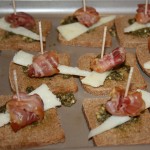
Berry cobbler is a sweet but (almost) healthy option for book club. Louise Erdrich’s book, The Round House, requires a saccharine dessert to offset its deep, weighty discussion.
Cranberry Bread – The Round House
This fruited bread is actually a Thanksgiving tradition in my house. We make multiple loaves and serve it with cream cheese. The combination is tangy, sweet, and unusual. And it is the perfect offering for your book club, as you discuss The Round House by Louise Erdrich.
Cranberry Bread
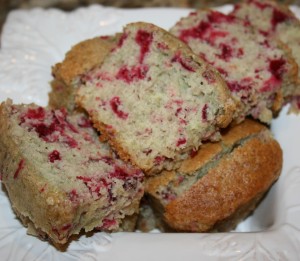 Ingredients
Ingredients
- 2 cups flour
- 1 cup sugar
- 1-1/2 teaspoons baking powder
- ½ teaspoon salt
- 2 Tablespoons butter or margarine, room temperature
- ¾ cup orange juice
- 1 egg (beaten)
- 1 cup cranberries, halved
- 1/2 cup chopped walnuts (optional)
Directions
Preheat the oven to 350 degrees.
Slice your cranberries in half and set aside. It helps to cut them frozen and slightly thawed. Or pop them in the freezer for a ½ hour before you plan to cut.
Grease two bread pans.
Mix dry ingredients and toss lightly.
Add butter, orange juice, and egg and stir vigorously until combined.
Once mixed, fold in cranberries (and walnuts, optional).
Pour batter into pan and spread evenly.
Bake at 350 degrees for 40-50 minutes. Insert a toothpick to make sure the centers are cooked and firm. Serve with cream cheese.
Walnuts can be added to this sweet bread for extra texture and crunch. There are few things I look forward to at Thanksgiving more than Cranberry Bread. It makes a simple, delicious addition to your book club discussion of The Round House by Louise Erdrich.
The Round House – Discussion Questions
The Round House is Louise Erdrich’s 26th book and practice has made perfect. Riveting, paradigm-shifting, and expansive, The Round House has won the National Book Award as well as many others. It delves into race, religion, socioeconomics, truth, revenge, and justice. And it makes for a compelling discussion among your next book club meeting.
Book Synopsis
 One Sunday in the spring of 1988, a woman living on a reservation in North Dakota is attacked. The details of the crime are slow to surface as Geraldine Coutts is traumatized and reluctant to relive or reveal what happened, either to the police or to her husband, Bazil, and thirteen-year-old son, Joe. In one day, Joe’s life is irrevocably transformed. He tries to heal his mother, but she will not leave her bed and slips into an abyss of solitude. Increasingly alone, Joe finds himself thrust prematurely into an adult world for which he is ill prepared.
One Sunday in the spring of 1988, a woman living on a reservation in North Dakota is attacked. The details of the crime are slow to surface as Geraldine Coutts is traumatized and reluctant to relive or reveal what happened, either to the police or to her husband, Bazil, and thirteen-year-old son, Joe. In one day, Joe’s life is irrevocably transformed. He tries to heal his mother, but she will not leave her bed and slips into an abyss of solitude. Increasingly alone, Joe finds himself thrust prematurely into an adult world for which he is ill prepared.
While his father, who is a tribal judge, endeavors to wrest justice from a situation that defies his efforts, Joe becomes frustrated with the official investigation and sets out with his trusted friends, Cappy, Zack, and Angus, to get some answers of his own. Their quest takes them first to the Round House, a sacred space and place of worship for the Ojibwe. And this is only the beginning.
-From the publisher, Harper Collins
Discussion Questions for The Round House
Louise Erdrich’s publisher, Harper Collins, offers a lengthy list of discussion questions. As always, consider these additional questions as well:
- Why do you think the author chose to have Joe narrate the story? How did his perspective color/influence the story?
- How do we struggle with reaching/helping people who are caught in the cycle of grief? Joe can’t reach his mother and force her to resume living. How do we force/or drop the ball on others who need help?
- Can you name an instance when you reached out to help someone struggling? Did it end well or was there an adverse reaction?
- Why do you think Joe’s mother wouldn’t name the place where the rape occurred? Do you think she truly didn’t know or is she keeping quiet? Considering the crime of rape is true, do you think it would be ethical of her to bend the facts on the location?
- Joe is 13 when his mother is raped, which is a pivotal coming of age time for boys. Do you think his actions and reactions would have been different if he had been 8 or 9? What about if he was 18?
- What is your definition of justice? Does perspective, relationship, time, space, etc. affect justice?
- Have you ever sat on a jury? Do you think you are a good judge of character?
- If Joe were to stand trial for the murder of his mother’s rapist, how do you think he would be found? Guilty? Not guilty? How would you vote?
- What’s your opinion on the balance in the universe? His friend had to die at the end, because a death equaled a death. Do you think the universe finds equilibrium?
A few related foods will be will be featured this week, including Cranberry Bread, Faux Steak Res Sandwiches, and Triple Berry Cobbler.
May words nourish your soul.
Flowered Shortbread Rounds – The Language of Flowers
The Language of Flowers by Vanessa Diffenbaugh requires a floral treat. Luckily there are several edible flowers to incorporate into your food including: cornflower, gardenia, impatiens, lavender, nasturium, pansy, snapdragon, violet, etc. A basic, buttery shortbread is the perfect accent for sweet, tender flower petals.
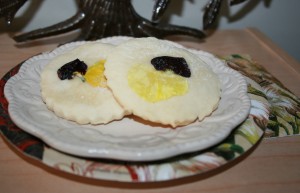 Flowered Shortbread Rounds
Flowered Shortbread Rounds
- ½ cup (one stick) unsalted butter, at room temperature
- ½ cup 10x confectioner sugar
- 2 cups flour
- 1 teaspoon extract of your choice (suggested: lemon extract, strawberry extract, vanilla extract, etc.)
- One package of edible flowers (organic and untreated)
Preheat the oven to 350 degrees.
Cream the butter, sugar, and extract together until thoroughly mixed.
Add flour and finish stirring by hand until incorporated. It will have a crumbly texture but will stick together when pressed.
Roll out to ¾” thickness and using a round cookie cutter cut several shortbread rounds. Reuse dough scraps to create more rounds.
Place on an ungreased cookie sheet and bake at 350 degrees for 12-15 minutes until cookies are firm.
Remove from oven and brush tops with an egg white mixture (one egg white mixed with one Tablespoon of water.) Press 1-2 flower petals onto the top of the cookie and wash once again with egg white mixture.
Sprinkle sugar over the top of each cookie and place back in the oven for 5-10 minutes more, until the edges are lightly browned.
Cool and serve.
These delicate shortbread rounds are just as good without edible flowers, but in order to enhance your floral theme for your Language of Flowers book club meeting, consider adding the flowers. The flowers add a pretty touch as well as a sweet, interesting flavor.
The Language of Flowers – Discussion Questions
Word of mouth around the brilliance and beauty of The Language of Flowers by Vanessa Diffenbaugh spread like pollen among avid readers. People were captivated by the gritty, raw look at ageing out of the foster system, yet the language and story held delicate beauty as well.
Book Synopsis
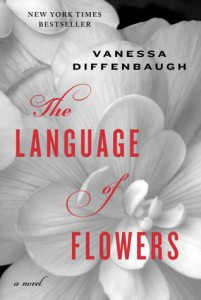 A mesmerizing, moving, and elegantly written debut novel, The Language of Flowers beautifully weaves past and present, creating a vivid portrait of an unforgettable woman whose gift for flowers helps her change the lives of others even as she struggles to overcome her own troubled past.
A mesmerizing, moving, and elegantly written debut novel, The Language of Flowers beautifully weaves past and present, creating a vivid portrait of an unforgettable woman whose gift for flowers helps her change the lives of others even as she struggles to overcome her own troubled past.
The Victorian language of flowers was used to convey romantic expressions: honeysuckle for devotion, asters for patience, and red roses for love. But for Victoria Jones, it’s been more useful in communicating grief, mistrust, and solitude. After a childhood spent in the foster-care system, she is unable to get close to anybody, and her only connection to the world is through flowers and their meanings.
Now eighteen and emancipated from the system, Victoria has nowhere to go and sleeps in a public park, where she plants a small garden of her own. Soon a local florist discovers her talents, and Victoria realizes she has a gift for helping others through the flowers she chooses for them. But a mysterious vendor at the flower market has her questioning what’s been missing in her life, and when she’s forced to confront a painful secret from her past, she must decide whether it’s worth risking everything for a second chance at happiness.
From Ballantine
Discussion Questions for The Language of Flowers
Vanessa Diffenbaugh’s publisher has a nice list of discussion questions at their website. For a deeper, more personal discussion, consider adding the following:
- Flowers are often considered luxuries and frivolous. For this lost girl, why do flowers speak to her? Why does she put stock in something so temporary and fragile?
- Were you able to connect with Victoria on the page, even with her intimacy issues? Would you like her if you met her in real life? Why or why not?
- What gifts do we receive when we are flooded with early unconditional love? Can we rectify a deficit of early connections and love?
- Change is necessary in life. What is the tipping point for too much change? How important is security for growth?
- How does motherhood distill our thoughts on family? How do you think differently about motherhood before you had children and after?
- At what age is it appropriate to be considered independent and an adult? Does this age vary for people and circumstances? At what age were you entirely independent of your parents? Are parents always considered a safety net?
- What practical skills would you teach to those ageing out? (For example, cooking, taxes, self care, banking, etc.) Have you made a specific effort to teach your children these skills or do you think they pick them up through example?
- Victoria learned a lost language. Much like Latin, very few people understood the language of flowers. Why then was the inaccuracy of her language so world-changing to her?
- Have you ever had experiences with the foster care system? How can ageing out of the system be improved?
The Language of Flowers was optioned for film in 2011 but there is no current word on production (February 2013).
The author, Vanessa Diffenbaugh, is also the founder of the Camellia Network, which supports youth transitioning from foster care into independent lives.
On Wednesday, I will share the recipe for Flowered and Sugared Shortbread Rounds for your next book club.
Until then, may words nourish your soul.
Night Circus – Black and White Cookies on Red Velvet
The Le Cirque des Rêves is all about black and white, night and day. But the reveurs added a dash of scarlet red, to mark themselves to each other and to stand out. These gorgeous and soft cookies are the perfect nod to The Night Circus and its reveurs.
Red Velvet Black and White Cookies
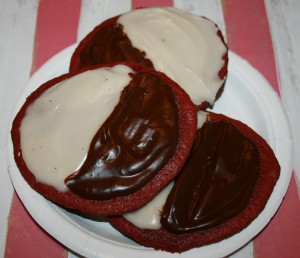 Adapted from Rachael Ray’s recipes (March 2008)
Adapted from Rachael Ray’s recipes (March 2008)
- 1-1/2 cups flour
- 1 Tablespoon cocoa powder
- ½ teaspoon salt
- 5 Tablespoons butter, at room temperature
- ¾ cup sugar
- 1 egg
- 1 Tablespoon red food coloring (or 1 teaspoon red food paste)
- 1 teaspoon vanilla extract
- ½ cup buttermilk
Preheat the oven to 350°.
Line two baking sheets with parchment paper. (Do not substitute foil or wax paper. Parchment paper is a must.)
Beat five tablespoons of butter with the sugar until fluffy. Beat in the egg, food coloring and 1 teaspoon vanilla.
Mix in cocoa powder, baking soda and salt until smooth.
Alternate 1-1/2 cups of flour and ½ cup buttermilk until it is all incorporated without overmixing.
Spoon about a 1/4-cup of batter 3 inches apart on the parchment papered baking sheet. Bake for 12-15 minutes at 35o degrees until the center is dry.
Let cookies cool for five minutes before removing from the parchment paper.
Black and White Frosting
- 2 cups confectioners’ sugar (10x sugar)
- 2 Tablespoons light corn syrup
- 3 Tablespoons butter, room temperature
- 3/4 cup semi-sweet chocolate chips
- 1 teaspoon vanilla extract
White Frosting
Whisk together the confectioners’ sugar, 1 teaspoon vanilla, 1 Tablespoon corn syrup and 2 Tablespoons hot water until smooth.
Black Frosting
In another bowl, combine the chocolate chips, remaining 3 Tablespoons butter, and 1 tablespoon corn syrup.
Microwave until melted, about 1 minute and stir vigorously. Microwave in 10 second increments until it is fully melted.
Frost the cookies with the white frosting, only covering half of the cookie, almost to the edge. Then frost with the chocolate icing, keeping a sharp edge. Cool until set. Store in an airtight container.
These classic cookies are the perfect cookie to accompany your book club discussion of Erin Morganstern’s The Night Circus. Serve them on a bright red platter with milk, coffee, or tea. The al dente frosting breaks smoothly over the yielding red velvet cookie creating a great mouth feel.
May words nourish your soul.
Night Circus – Discussion Questions
As a fellow participant of National Novel Writing Month (NaNoWriMo), I heard Erin Morgenstern’s name before she was actually published. Her debut book, The Night Circus, created a metric ton of ballyhoo prior to publication. She was touted as the next Harry Potter, even snagging the phenomenal Jim Dale to narrate the audio version of her magical book.
And like other NaNoWriMo success stories, the overnight success was preluded by years of hard work. “A very sprawling, very rough draft of The Night Circus was first written in a few different Novembers of NaNoWriMo. Almost the entire book was rewritten and revised before it got from there to the finished version. To give you an idea of how much: Celia isn’t in that first sprawling draft. It is a lot of stuff about the circus but not a lot of plot, but it gave me something to work from,” Erin has written on her blog.
But the professional polish and imaginative story stands alone, creating a wondrous world which will lasts long past the last page.
Book Synopsis
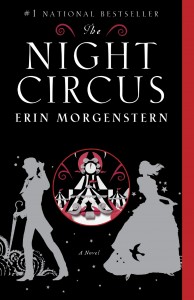 The circus arrives without warning. No announcements precede it. It is simply there, when yesterday it was not. Within the black-and-white striped canvas tents is an utterly unique experience full of breathtaking amazements. It is called Le Cirque des Rêves, and it is only open at night.
The circus arrives without warning. No announcements precede it. It is simply there, when yesterday it was not. Within the black-and-white striped canvas tents is an utterly unique experience full of breathtaking amazements. It is called Le Cirque des Rêves, and it is only open at night.
But behind the scenes, a fierce competition is underway: a duel between two young magicians, Celia and Marco, who have been trained since childhood expressly for this purpose by their mercurial instructors. Unbeknownst to them both, this is a game in which only one can be left standing. Despite the high stakes, Celia and Marco soon tumble headfirst into love, setting off a domino effect of dangerous consequences, and leaving the lives of everyone, from the performers to the patrons, hanging in the balance.
From Random House
Discussion Questions
Erin Morgenstern’s publisher, Random House, has a wonderful selection of book club discussion questions here. But as always, here at the Reader’s Feast, we have a few more questions to round out your discussion.
- The circus vignettes are disconnected from the narrative and written in second person, making them intimate, vivid, and memorable. Readers seldom encounter second person point of view. (Bright Lights, Big City by Jay McInerney is one of the few notable novels written in second person.) Was it jarring to you or did it draw you in? Could you imagine yourself at the circus?
- What tent or exhibition would you most want to visit? What foods would you want to taste? What feature would you avoid?
- Like magic, the story is revealed through sleights of hand—juggling the past with the present, hiding pertinent information until the last moment, and providing misdirection. How was the story enhanced (or lessened) by the tricks?
- Was it fair for the circus members to be pulled into a contract without their approval? Were the benefits (agelessness, travel, etc.) enough to outweigh the risks?
- Prospero has a mental and magical hold on Celia, including after his “death.” How can a ghost of a person be stronger than a real person?
- Marco and Celia struggle with balancing the ever-expanding circus. How is this a reflection of how we overextend ourselves?
- There are several pairings in The Night Circus. Marco and Celia, Poppet and Widget, Celia and Herr Thiessen, Marco and Isobel, and Tara and Lanie Burgess. Bailey is one of the few unpaired individuals. How does this make him different? Would he make a different decision about joining the circus if he was paired? Is Poppet enough for him or is she too closely paired to Widget to fully give herself to Bailey?
- Have you ever been behind the scenes of a circus, a play, a restaurant, a special production, etc? What was disconcerting about the behind the scene look? What took you by surprise?
- The reveurs were like followers of a cult. Today’s culture offers several cult options, such as certain events, movie franchises, some stories, etc. What elements are often found in a cult? (Some ideas: a universal truth, compelling characters, likeminded individuals, common ground, etc.)
- Who would you cast in the movie of The Night Circus, which is in the works?
- The circus would be nothing without its audience. Why do stories need to be told and heard to release their power?
The Night Circus by Erin Morgenstern is as magical as its many, varied tents. It is a book that invites us to visit repeatedly—studying for the sleights of hand, reimagining the character’s motivations and desires, and relishing its promised delicacies.
On Wednesday, I will share the recipe for Black and White Red Velvet cookies, with a nod towards the reveurs of the Le Cirque des Rêves.
Gone Girl – Mini Wedding Cakes
Readers of Gone Girl will see the irony of these sweet miniature wedding cakes when served as a book club treat. They are delicious and easy to assemble, with a subtle almond flavoring in both the cake and the petit fours frosting.
Miniature Wedding Cakes
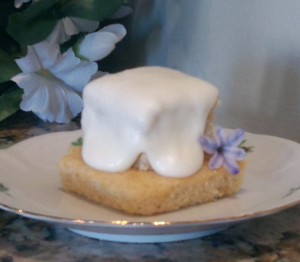 This is a basic white sheet cake, assembled into wedding cake shapes and dolloped with almond flavored frosting.
This is a basic white sheet cake, assembled into wedding cake shapes and dolloped with almond flavored frosting.
Directions
Preheat oven to 375 degrees. Spray a 15” by 10” by 1” jelly roll pan with Pam or cooking spray.
In a large saucepan, to boil:
- 1/2 cup butter
- 1/2 cup water
Remove from heat. Stir in following ingredients:
- 2 cups flour
- 1-1/2 cups white sugar
- 2 eggs
- 1/2 cup sour cream
- 1/2 cup applesauce
- 1 teaspoon baking powder
- 1/4 teaspoon baking soda
- 1 teaspoon salt
- 1 teaspoon almond extract
Once smooth, pour into the baking pan.
Bake at 375 degrees for 15-20 minutes. Cool completely.
With a greased sharp knife, cut several 3” by 3” squares and an equal number of 1” by 1” squares. For ease of frosting, place the cut squares into the freezer for about an hour while you are preparing the frosting.
Petit Fours Frosting
Mix together all of the following ingredients:
- 1/4 cup butter, melted
- 1/2 cup light corn syrup
- 1 teaspoon almond extract
- 3 cups confectioners’ sugar
- 2 Tablespoons of heavy cream
Add heavy cream, as needed to make a pourable smooth frosting.
Assemble your slightly frozen larger squares on a baking rack. Add a small amount of frosting to each one and place a smaller square on top. Using a large spoon, dollop a liberal amount of frosting over the top of each stacked square, letting it drizzle down the sides.
Let the frosting stiffen before serving. Add small decorations, if you’d like. This could include nonpareils, fresh flowers, frosting accents, etc.
The almond flavoring and sweet frosting is a definite contrast for the dark book, Gone Girl. Serve up some sweetness and light while you discussion Amy and Nick’s disturbed marriage.

